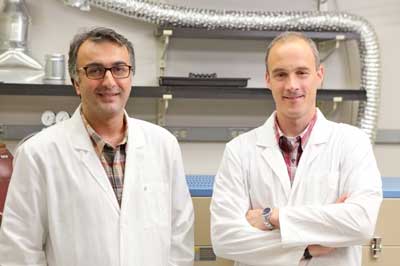| Posted: Sep 27, 2017 |
Finding 2D materials to make batteries cheaper, better
(Nanowerk News) The University of Illinois at Chicago has received a $1.44 million National Science Foundation grant to discover new 2D materials that can be used to manufacture better and cheaper batteries.
|
|
Two-dimensional materials, of which graphene is the most common, are extremely strong, lightweight, flexible, and excellent conductors of heat and electricity. Graphene is one million times thinner than paper, nearly transparent and believed to be the strongest material in the world.
|
|
Since the discovery of graphene in 2004, about 700 2D materials are predicted to be stable; many remain to be synthesized. The global market for 2D materials is expected to reach $390 million within a decade.
|
|
Amin Salehi-Khojin, assistant professor of mechanical and industrial engineering, and Robert Klie, professor of physics, want to not only improve the performance of 2D materials — molybdenum disulfide is a promising candidate, they believe — in a battery but to understand how they function.
|
 |
| Amin Salehi-Khojin (left) and Robert Klie.
|
|
“We want to find new catalyst materials that can increase a battery’s efficiency significantly, not incrementally,” Salehi-Khojin said. “We believe that the new materials can increase its performance for electrochemical reactions by about 1,000 times, compared to existing materials. This will be revolutionary.”
|
|
Salehi-Khojin’s and Klie’s research will incorporate 2D materials with an ionic liquid to elicit an electrochemical reaction that can be used to generate sustainable energy, manufacture chemicals, store energy and remove pollution or contaminants from soil, groundwater, sediment or surface water.
|
|
“Electrocatalysis, as used in energy storage and conversion devices such as advanced batteries, fuel cells, photovoltaics and chemical electrolyzers, is becoming an increasingly important alternative to conventional thermal catalysis,” Klie said. “However, further improvements are needed in efficiency, cost reduction and chemical selectivity before it can be commercially marketed.”
|
|
The batteries, Salehi-Khojin said, can be used in various ways — from operating automobiles to providing emergency power when needed. The technology can eventually be used in an electric grid to deliver electricity from producers to consumers, he said.
|
|
During the four year grant cycle, Salehi-Khojin and Klie will be assisted by researchers at Washington University of St. Louis and Argonne National Laboratory, as well as doctoral and undergraduate minority students through UIC’s Minority Engineering Recruitment and Retention Program (MERRP) and select high school students.
|

